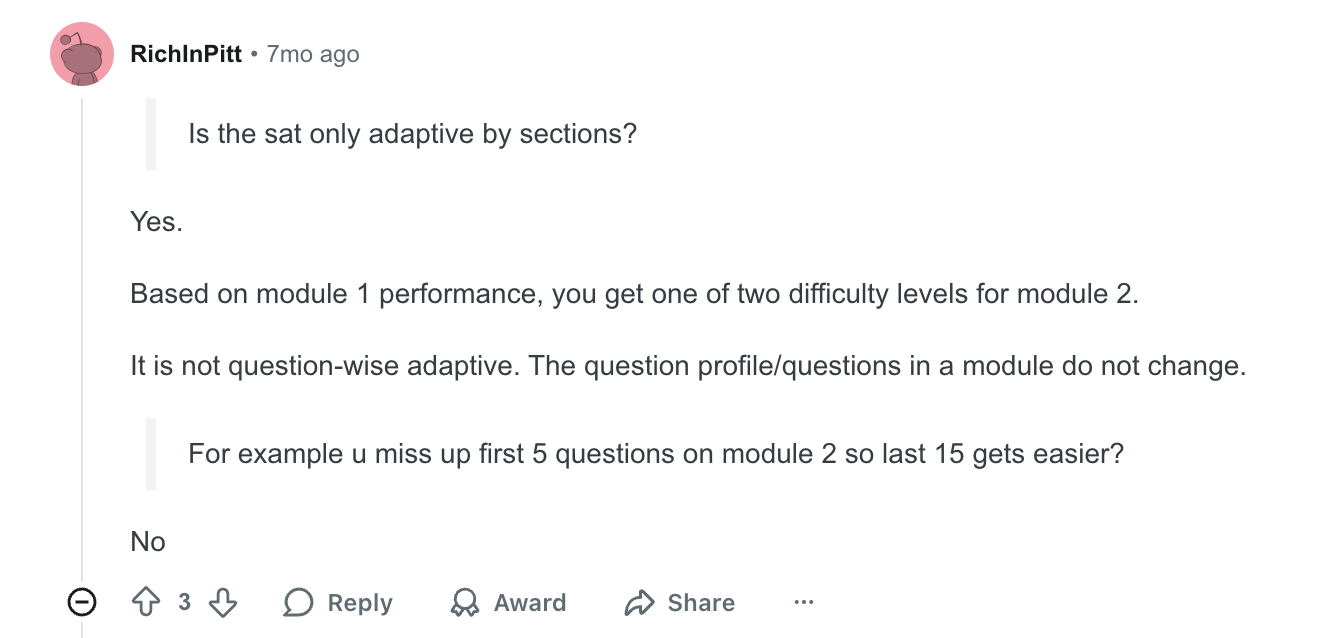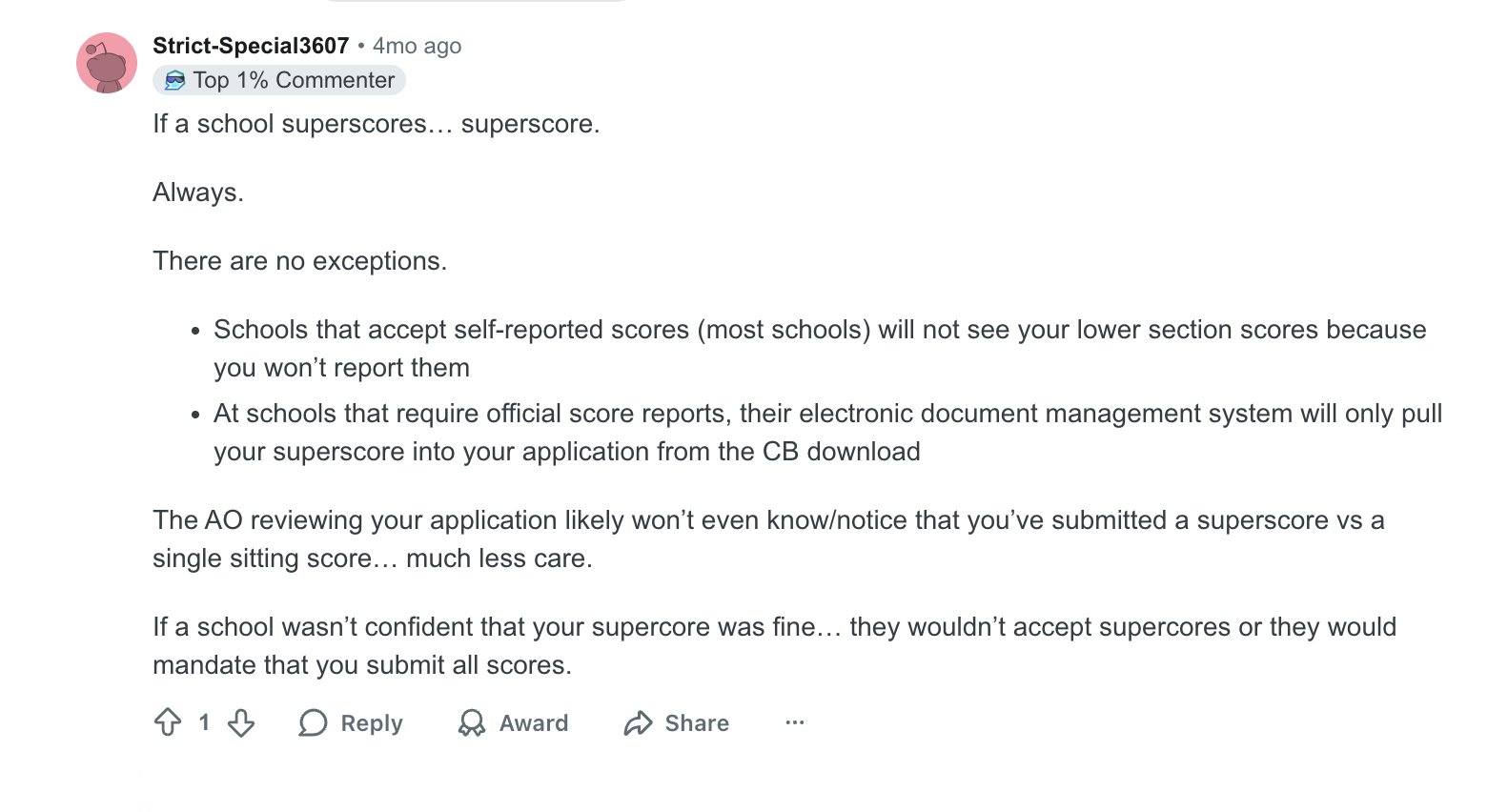




Key Takeaways
- The digital SAT makes retakes smarter, faster, and more data-driven for tutors and students.
- Superscoring and faster score reports turn every retake into a new opportunity to improve.
- Strategic, focused prep helps tutors turn SAT retakes into confident student success stories.
Think of retaking the SAT as a second swing, but this time, you already know where you already know where your student missed.
In 2025, an increasing number of students are taking that second swing compared to previous years. A few extra points can mean the difference between a good college and a dream college, or even scholarships that can be a make-or-break decision.
As tutors, you can be the quiet power behind their comeback stories as they take this second swing. With the new digital SAT, faster score reports, and smarter prep tools, retakes can be much more strategic. From analyzing score reports to helping students rebuild confidence, you can turn every retake into a win.
In this guide, we’ll give you eight tips for retaking the SAT that you can start applying to your students right away. It will help them boost their confidence, SAT scores, and open the doors to their dream colleges.
Why More Students Are Retaking the SAT in 2025
If 2024 was the year students survived the SAT’s digital shift, 2025 is the year they use it to strategize test-taking. Retaking the SAT has become less about just giving another try and more about a smart, data-driven move tutors use to prepare students to get the highest scores.
Here are five reasons behind increased retakes in 2025:
- The Digital SAT: The switch to the computer-based SAT means shorter modules, adaptive sections, and sleek on-screen tools. The digital format provides instant clarity on what needs work, and tutors can design hyper-focused drills on the specific question types students missed.
- Faster, Sharper Feedback: Score reports today come with detailed breakdowns, and you can point out exactly which skills need attention. Maybe a student aces algebra but stumbles with data problem-solving. Instead of guessing, tutors can now pinpoint what students should do — and not do — for the digital SATs, using what’s holding them back to rebuild.
- Score Choice and Superscoring: Most colleges now let students submit only their best section scores. So if a student crushes Math on one test and Reading on another, they can combine the two. This “superscore” policy takes the pressure off, and every retake becomes a chance to improve, not just a gamble.
- Scholarships Still Love Strong SAT Scores: Even in a test-optional world, higher SAT scores open doors — especially financial ones. A few extra points can mean the difference between qualifying for merit-based scholarships and standing out in competitive applications.
- Better Prep, Less Guesswork: Between official practice from Khan Academy and digital testing tools like EdisonOS, students have access to world-class prep without breaking the bank. Tutors who pair structured lessons with these resources see their students improve faster and walk into the retake with confidence rather than uncertainty.
How the Digital SAT Changed the Retake Calculation
When the SAT went digital, it didn’t just swap paper for pixels; but it also rewrote the retake playbook. Students and tutors now have better data, faster feedback, and more strategic control over when and how to take their next shot.
1. Adaptive Modules Reshaped the “Score Curve”
In the old SAT, everyone faced the same fixed test, so retake improvements came mostly from better content prep.
But now, the digital SAT’s adaptive modules personalize difficulty. That means small improvements in early performance can unlock a higher overall score.
For tutors: Retake prep shouldn’t just be about covering content gaps. Help students optimize their approach to the start and teach them to pace the SAT confidently through the first module. If they do well, the algorithm will serve up a higher-level second module and a better-scaled score.
Here’s how SAT adaptive modules work, as discussed on Reddit:

2. Faster Scores, Smarter Scheduling
The digital SAT delivers results in days, not weeks. That faster feedback loop lets tutors make data-informed retake decisions sooner.
Instead of waiting a month to see if a retake is worth it, you can analyze results immediately, pinpoint sections for improvement, and schedule the next test before application deadlines close.
Think of it as an agile testing cycle: test → analyze → adapt → retake.
For tutors: Real-time analytics in EdisonOS make it easier to break down the digital SAT score report, giving you detailed skill-level breakdowns to adjust prep between attempts.
3. Superscoring Made Section-Based Retakes Worthwhile
Superscoring isn’t new, but it’s become far more powerful in the digital era. Because scores come faster and reports are more transparent, tutors can now plan retakes with section-specific intent — e.g., improving only Math this time because Reading is already strong.
Here’s how it works:

It’s important to note that not all schools accept superscores, but if they do, a 30-point bump here can shift scholarship opportunities or admission tiers for the student.
Here’s how one Reddit user explains the benefit and how superscoring works:

For Tutors: Help students understand superscoring early. Show them how improving just one section can boost their overall score, and use that insight to design focused prep blocks.
4. Richer Data = Precision Retakes
The digital SAT’s score reports now include granular skill data, such as Command of Evidence, Linear Functions, and Rhetorical Synthesis. That means tutors don’t have to guess where improvement is possible; they can see it.
For tutors: Instead of repeating a broad content review, you can build personalized mini-tests that target exactly what the first test revealed. Every retake becomes laser-focused — shorter study cycles, higher impact.
With EdisonOS, tutors can skip the spreadsheets and focus on strategy. Its built-in tools turn digital SAT prep into a smart, repeatable system designed for measurable score gains. Here’s how:
- Create targeted mini-tests with Build Your Own Tests (BYOT): Focus only on the sections that need improvement to help students boost their superscore.
- Use real-time analytics: Break down digital SAT score reports, track skill-level progress, and adapt lessons between attempts.
- Run authentic digital simulations: Mirror the official SAT interface, complete with adaptive modules, on-screen tools, and timers.
- Deliver personalized reports: Show parents and students exactly how their performance is improving.
EdisonOS is built for tutors who want precision, not guesswork. Simplify retake prep, streamline reporting, and give your students the closest experience to the real SAT.
Explore Digital SAT Prep on EdisonOS
How to Decide If a Retake Is Right for Your Student
Not every student needs a retake, but when the opportunity is seized by the right one, it can make a measurable difference. Here’s how to determine if it’s worth it:
- Target score gap: Compare your student’s current score to the 75th percentile at their target colleges. If there’s a noticeable gap, even 20–30 points, a retake could strengthen their application or qualify them for more scholarships.
- Clear, fixable weaknesses: Review detailed score reports. If only a few skill areas are lagging, such as punctuation or data interpretation, a targeted study plan can quickly close those gaps. If weaknesses are broad, the student may need a longer prep cycle before retesting.
- Timing and workload: Retakes are most effective when there’s adequate prep time. Students who test in the spring of junior year often benefit from a summer or early fall retake. If deadlines are approaching, consider whether the student can realistically improve in time.
- Motivation and mindset: A retake should build confidence, not add pressure. If a student is exhausted or anxious, pushing for another attempt can backfire. Gauge readiness before committing to a test date.
- Cost-benefit analysis: Consider SAT pricing, which includes registration fees and tutoring hours, against the potential payoff. If the expected score gain won’t meaningfully affect admissions or scholarships, focus energy on essays or academics instead.
Bottom line: Recommend a retake only when there’s clear evidence of improvement potential, supported by data, time, and student commitment.
8 Tips for Tutors Helping SAT Retakers
Helping students prepare for a retake isn’t about starting from scratch; it’s about building smarter from what’s already known.
Here are eight surefire tips for tutors to make retakes more strategic, efficient, and effective.
1. Analyze Your Student’s Previous Performance
Start with data, not guesses.
Review the student’s digital SAT score report or practice test analytics to pinpoint weak areas, whether that’s algebraic manipulation, transitions in writing, or data analysis.
Both the College Board and EdisonOS break scores into specific skill domains, making it easy to see where points were lost.
Use those insights to build custom drills or mini-tests focused only on those topics.
2. Set Realistic Score Goals
Every student wants a big jump, but improvement depends on where they’re starting.
Look at the SAT ranges of target colleges (especially the 75th percentile). Then set a clear, achievable goal based on effort and timeline.
Even small gains like 20 to 40 points in a section can improve a superscore or unlock new scholarship brackets. A defined target keeps both student and tutor accountable.
3. Create a Structured Study Plan
Turn preparation into a schedule, not a scramble. You don’t need your students to take practice tests every day. You can strategize how often they need to take the test and break the study period into weekly goals of concept review, section practice, and timed tests.
For example:
- Weeks 1- 2: Strengthen math fundamentals and grammar rules.
- Weeks 3 - 4: Focus on problem-solving, reading speed, and endurance.
- Weeks 5 - 6: Full-length digital mocks, review, and refinement.
Consistent structure prevents burnout and builds test-day stamina.
4. Focus on Students’ Weak Areas
Improvement happens fastest when effort is targeted. Resist the temptation to practice everything equally, and instead, assess your student’s strengths and weaknesses.
If reading comprehension is strong but data analysis drags scores down, shift time accordingly. On EdisonOS, tutors can filter practice questions by topic or skill, ensuring each session zeroes in on specific weaknesses.
5. Help Students Practice Time Management
The digital SAT’s adaptive modules make pacing critical. Have students take full-length, timed mock tests under exam conditions, ideally on a device similar to what they’ll use on test day.
Use digital SAT simulations to mirror the real interface, including timers and adaptive sequencing. Review timing data afterward to find where students slow down, then teach strategies for skipping or flagging questions without losing momentum.
6. Maintain Student’s Mental and Physical Health
Peak performance isn’t just about studying; it’s also about energy, sleep, and mindset.
Research shows that even short daily exercise can improve concentration and memory, while 7to 8 hours of sleep consistently improves test performance by up to 10%. Encourage students to manage stress with routines that include movement, balanced meals, and rest.
A calm, rested student will retain more and perform better under pressure.
7. Utilize Quality Study Materials
The best prep tools simulate the real test. Combine the College Board’s Bluebook with the best online tutoring services for the most authentic experience.
Choose providers like EdisonOS that provide full-length adaptive tests, question-level analytics, and scaled scoring so tutors can track growth over time. The insights from these platforms can help adjust lessons, reinforce progress, and celebrate measurable wins.
8. Plan the Retake Strategically
Timing matters as much as preparation.
Choose a test date that leaves enough room for focused study, typically two months or three months after the previous attempt. Use Score Choice to submit only your best scores, and take advantage of superscoring, where colleges combine the highest section scores from different test dates.
Encourage quality over quantity, as one well-prepared retake usually outweighs multiple rushed ones.
When in doubt, focus on a single, data-backed plan and not another test for the sake of it.
Why Tutors Love Using EdisonOS for SAT Retakes
Every strategy in this guide — from analyzing weak areas to timing a strategic retake — becomes easier with the right tools.
EdisonOS was built for tutors who want data-driven control over every step of the SAT prep process. Here’s how it supports smarter, faster improvement:
- Build Your Own Tests (BYOT): Create mini-tests focused on the exact skills each student needs to improve. Upload your own questions or draw from EdisonOS’s 5,000+ SAT-ready items to deliver precise, personalized practice.
- Tutor Mode: Give instant, guided feedback during practice sessions. When students see correct answers and explanations in real time, mistakes turn into immediate learning opportunities.
- Authentic Digital Testing Environment: EdisonOS replicates the SAT’s digital interface, including adaptive modules, timers, and more. Students gain familiarity and confidence by practicing in the same conditions they’ll face on test day.
- Smart Analytics and Scaled Scores: Get detailed performance insights after every test. And we don’t just mean section scores; we also include skill-level patterns, time spent per question, and difficulty trends. You can instantly see where students are losing points and adjust study plans accordingly.
- Integrated Tutoring and Progress Tracking: Combine live sessions, homework assignments, and ongoing diagnostics in one platform. EdisonOS keeps every data point connected, helping tutors monitor growth week by week and show parents measurable progress.
In short, EdisonOS doesn’t replace a tutor’s expertise; it adds to it. With automated scoring, actionable analytics, and realistic test simulations, you can deliver a more efficient and personalized retake experience for every student.
Conclusion and Key Takeaways
A successful SAT retake is about studying smarter, and tutors who use data, structure, and strategy help students make real progress where it matters most. Here’s what to remember:
- The digital SAT changed how students should prepare — it’s now shorter, adaptive, and data-rich.
- Analyze performance before planning; use score reports to target skills with the highest payoff.
- Set focused goals and design a structured plan that fits each student’s timeline.
- Train with realistic tests to build confidence and improve pacing.
- Use analytics to measure progress and refine strategy between attempts.
With the right balance of guidance, data, and digital readiness, every retake becomes an opportunity for growth, and not pressure. If you’re ready to make your students’ next SAT their strongest yet, explore EdisonOS, the tutoring platform designed to turn practice into measurable results. Book a demo with EdisonOS to get started with SAT prep for your students.
Frequently asked questions
If your score already falls within or above the 75th percentile for your target colleges, a retake may not add much value. But if a small boost could improve scholarship eligibility or meet competitive cutoffs, a focused retake with data-driven prep can be worthwhile. If your score already falls within or above the 75th percentile for your target colleges, a retake may not add much value. But if a small boost could improve scholarship eligibility or meet competitive cutoffs, a focused retake with data-driven prep can be worthwhile.
There’s no official limit, but most students take the SAT two or three times. Each attempt should have a clear goal, improving specific sections or timing. More than three tests rarely yield major gains unless preparation changes significantly between attempts.
Start by analyzing your previous results to identify weak skills. Create a structured study plan, focus on those areas, and take full-length digital practice tests under real conditions. Track progress with detailed analytics, adjust strategies, and emphasize quality practice over quantity.
Use your score report to target specific question types, practice under timed conditions in a digital interface, and aim to improve one section at a time for superscoring. Simulate official test conditions with adaptive mocks to build comfort, accuracy, and pacing.
Plan for six to twelve weeks of structured study between tests. Use the first few weeks to review weak concepts, the middle for practice tests, and the final stretch for timing and strategy refinement. The key is consistent, targeted preparation, and not just repetition.
No. Colleges typically consider only your highest scores and often superscore across test dates. Multiple attempts aren’t penalized, but too many without improvement can suggest poor planning. Retake only when your data and readiness indicate a realistic chance of progress.
Tutors Edge by EdisonOS
in our newsletter, curated to help tutors stay ahead!
Tutors Edge by EdisonOS
Get Exclusive test insights and updates in our newsletter, curated to help tutors stay ahead!











.png)
.webp)
